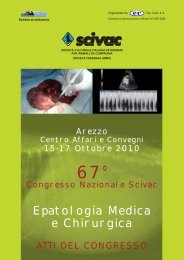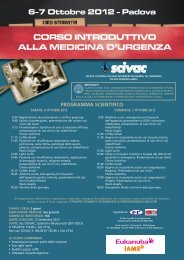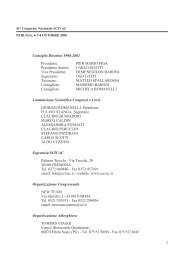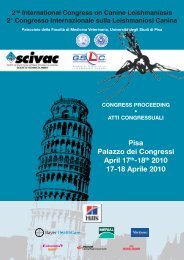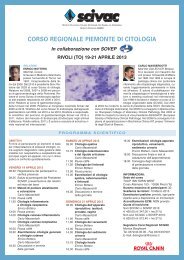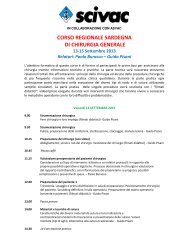58° Congresso Nazionale SCIVAC: Oncologia veterinaria
58° Congresso Nazionale SCIVAC: Oncologia veterinaria
58° Congresso Nazionale SCIVAC: Oncologia veterinaria
Create successful ePaper yourself
Turn your PDF publications into a flip-book with our unique Google optimized e-Paper software.
58° <strong>Congresso</strong> <strong>Nazionale</strong> <strong>SCIVAC</strong> • Milano, 7-9 Marzo 2008 • <strong>Oncologia</strong> <strong>veterinaria</strong> - Alle soglie del III Millennio<br />
Mechanism of action<br />
The mechanism of action is presumed to be the same as for cyclophosphamide.<br />
Subtle differences in the molecular pharmacology of the two drugs<br />
are possible because of the different locations of the two chloroethyl chains<br />
on ifosfamide.<br />
Pharmacokinetics<br />
Activation of the ifosfamide prodrug is by hydroxylation in the liver by<br />
cytochome p450. Ifosphamide becomes a strong electrophile by forming carbonium<br />
ions or transition complexes with target molecules in tissues.<br />
This results in the formation of covalent bonds through the alkylation of<br />
phosphate, amino, sulfhydryl, hydroxyl, carboxyl and imidazole groups. Its<br />
cytotoxic properties are due to its alkylating effects on DNA.<br />
Approximately 50% of the dose of active ifosfamide is excreted in the urine.<br />
The half-life in humans is schedule dependent; at high doses in human<br />
medicine the terminal half-life is 16 hours, while divided daily doses yield a<br />
terminal half-life of 7 hours.<br />
Ifsofamide has been used in veterinary medicine at doses of 350-375<br />
mg/m 2 IV in dogs, along with a vigorous intravenous diuresis protocol using<br />
mesna as a urothelial protectant.<br />
Surprisingly, dose escalation studies have shown the dose appropriate for<br />
cats is 900 mg/m 2 IV, with the diuresis protocol decribed hereafter.<br />
The diuresis protocol reported used mesna intravenously at 20% of the calculated<br />
mg dose of ifosfamide with 0.9% NaCl at a rate of 18.3 ml/kg/hour<br />
for 30 minutes prior to ifosfamide administration.<br />
Ifosfamide is given over 30 minutes, while intravenous saline diuresis is<br />
continued at the above infusion rate, with additional bolus doses of mesna as<br />
above at 2 and 5 hours. This protocol is repeated at 3-week intervals. The mechanism<br />
of resistance is presumed to be the same as for cyclophosphamide.<br />
Cross-resistance with cyclophosphamide is considered likely, although not<br />
absolute for all cases.<br />
Toxicity<br />
The primary toxicities of ifosfamide are myelosuppression and urothelial<br />
toxicity, but alopecia, nausea, vomiting and CNS effects have also been seen<br />
in human medicine. Ifosfamide can cause a Fanconi-like syndrome, as well as<br />
tubular and glomerular damage.<br />
71



